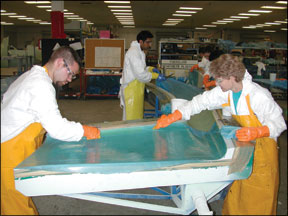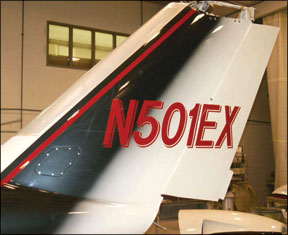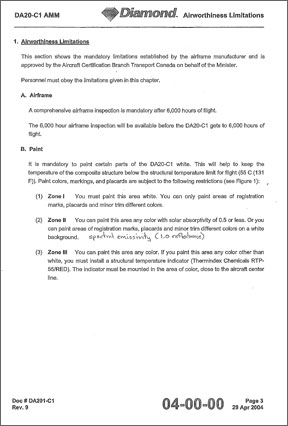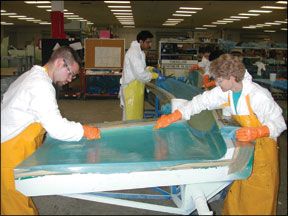The repainting process is different for composites than for aluminum, at least in a couple of critical areas. All of those areas could be summed up in the words “manufacturers specifications.” That is, each manufacturer has its own dos and don’ts when it comes to stripping off old paint and putting on new stuff. The short answer for how to get the job done right is to find a shop that has done that make of aircraft and has happy customers. Unfortunately, many competent paint shops havent had to do a full repaint of a Cirrus or a Diamond yet. Is it worth trekking hundreds of miles to a shop that has a few under their belt, or working with a local gang with a good reputation knowing they will be learning on your aircraft? We think that depends on the attitude and other relevant experience of the shop. The big issue is in how they prep the aircraft before painting.
The Striptease
Depending on which aircraft youre talking about and what parts are composite, chemical paint strippers are either forbidden or just “not recommended.” All of the shops we spoke with stripped old paint off composites by sanding. Thats mostly hand sanding, too, as bead blasting can raise the temperature of some parts high enough to compromise the composite substrate itself. If the shop you talk to mentions putting chemicals on your composite aircraft, we recommend you head for the exit right then.
As an aside, the Grumman Yankee/Cheetah/Tiger line has a similar issue. They are bonded aluminum and some unlucky owners found out that chemical strippers would degrade the glue that bonded the skins to the ribs and formers.
Sanding means effort and time, and time usually cranks up the cost. The odd part of our research was that shops seemed split on how much more time it took to prep a composite aircraft. Some shops said the net time was about equal to an aluminum airplane on prep. They figured the extra time in sanding was balanced by less time spent masking and dealing with the chemicals. Other shops said it was 20- to 30-percent more

Photos courtesy Oxford Aviation
time to prep the aircraft with only sanding.
Digging deeper, we found part of the difference is an apples-to-oranges problem. If the paint is in relatively good shape, then the sanding doesnt need to go down to the base primer, which saves a bit of time and expense. Other shops insist on getting down to the point where they can check for any porosity or production issues and correct it. Make sure you know what level of prep the shop is planning for your job.
Sanding also takes a high degree of skill to do correctly. Sand too deeply and youre suddenly looking at a composite repair job. Even just uneven sanding can result in a wave you wont see until there’s a shiny linear polyurethane polymer hardened across the surface.
It also matters which aircraft youre talking about. A Columbia/Corvallis 350/400 or a Diamond DA40/DA42 has a conductive primer thats part of the P-static dissipation system. Compromise that during sanding and it must be reapplied before any paint goes on top. Failure to do so could result in persistent radio static. Were told this isn’t an issue with repainting a Cirrus. The take-away here is you want a shop that has experience with composites.

That may be easier said than done. We surveyed the top paint shops recommended in our December 2006 survey. Only three had done full-fuselage repaints of composite aircraft. Two shops had done exactly one, while a second had done three.
But thats not to say the shops didnt have experience with composites. Many had done dozens of composite experimental homebuilt aircraft. Those planes didnt have to be stripped of the old paint and the restrictions for painting homebuilts are just recommendations by the kit supplier. Every shop we spoke to emphasized the need to know and follow the manufacturers procedures for repair and painting for certified birds. Several also noted that the exact specs for each manufacturer varied quite a bit. So, if you can find a shop thats done your make of aircraft, great. If not, get involved and make sure they are up to speed on the requirements and quirks of your aircrafts paint.
One potential gotcha is weight gain. The shops are sanding down to the old prime but not through it, and then adding their own prime on top to ensure good paint bonding. Even in a perfect world, the repainted aircraft will have a coat slightly thicker than the original was. The change to your empty weight shouldnt be a problem, but expect it to be a positive number.
The New Coat
Color-or lack thereof-was an issue with early composite aircraft and is still a factor to some degree. The problem is that darker colors can absorb sunlight and heat up more than lighter ones. This is especially an issue for Diamond aircraft that use a lower “glass transition temperature” in their resins.

The solution was simple: The airplane can be any color you want as long as its white.
As the manufacturers experimented more with paint mixes and got more field time with the aircraft, it was clear some areas, such as the cowl and cabin, could be painted with darker colors if the correct reflectivity was maintained. But before you get too excited by the two-color paint jobs of a newer Cirrus or Cessna Corvallis, know that the color restrictions for your aircraft are set by the maintenance manual for when your serial number actually rolled off the assembly line. An older Cirrus that was restricted to white only is probably stuck being white.
That said, there may be some room for creativity. Pearled finishes cost more, but they might still meet the spec. Diamond aircraft were usually painted all white, but they are actually allowed to have dark colors on the bottom and medium darkness on the sides, even if they werent originally delivered that way.
One plus in many cases is that certified composite aircraft were painted with automotive paint. This means the paint used is not obscure or outlandishly expensive, and the potential color palette (for approved areas) is huge.
Many of the composite aircraft had their accents and N-numbers applied as vinyl decals. You don’t have to go that route for the repaint if you don’t want to, which offers more flexibility in the final look. Weve also heard that the kits for those decals for some aircraft, the Cirrus was singled out, are more expensive than it would cost to paint the same details on the airplane.
Additional Options

One of the side benefits of the automotive-grade paint and rivet-free surface on composite aircraft is that old dull paint can be polished, or wet sanded, back to a shine. Diamond in particular applied its topcoat in a thick layer for exactly this reason. If there’s no damage that needs repair, this could be an excellent, and less expensive, way to get a nearly-new looking aircraft.
If you do get the full repaint, all the standard concerns of repainting any aircraft apply. Youll want to do a meticulous check of the entire surface for any imperfections you want corrected before you accept the aircraft. Control surfaces have individual weight and balance limits to prevent flutter, and any hint of a problem on flights post-paint should be brought back to be corrected.
Once its all done, stand back and admire the work. One of the best things about composite aircraft is how good they can look when all those swoopy curves are polished to a high shine.


